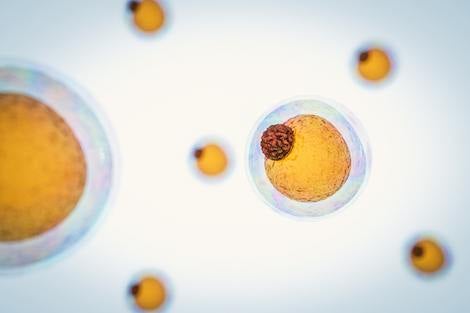For immediate release: April 4, 2019
New research led by Harvard T.H. Chan School of Public Health has identified numerous genes that influence how cells respond to saturated fatty acids. Some of these genes have promise as potential therapeutic targets for treating metabolic diseases associated with lipotoxicity, including obesity, diabetes, and heart failure.
The study also provides new insights into how saturated fatty acids trigger cellular stress and showed that saturated fatty acids are less toxic to cells when they are combined with unsaturated fatty acids.
“This study, which analyzes all genes in the human genome, provides a wealth of new information for how saturated fats harm cells. It not only sheds light on the biology but also identifies a number of new targets for possible therapies,” said corresponding author Robert Farese Jr., chair of the Department of Molecular Metabolism at Harvard Chan School.
The study was published in the April 4 print edition of Molecular Cell. The findings were reported from the laboratory of Farese and Tobias Walther, who study lipid metabolism in a joint laboratory.
Saturated fatty acids, which are found in foods such as red meat, cheese, and butter, are generally considered bad for health and can raise levels of “bad” LDL cholesterol. When consumed, saturated fatty acids are processed in many different ways. They can be used by cells as building blocks for membrane lipids, stored in lipid droplets, or used to modify proteins. While it’s known that the accumulation of saturated fatty acids can lead to cell and tissue “lipotoxicity,” a metabolic syndrome that is associated with various diseases including diabetes and obesity, very little is known about the various cellular pathways involved in mediating and modifying the toxic effects of saturated fatty acids.
In this study researchers exposed human cells to the saturated fatty acid palmitate, which is found in palm oil. They then examined how this exposure affected a cell’s RNA and its lipids, as well as the genetic interactions that occurred in response to palmitate.
The study revealed that when saturated fatty acids flow unchecked into complex lipids within cells, the process causes massive cellular stress that can ultimately kill the cell. However, when saturated fatty acids were prevented from being incorporated into these complex lipids, cell death was prevented. For example, the researchers found that the enzyme GPAT4 plays a critical role in regulating lipotoxicity. They discovered that blocking the enzyme prevents the entry of saturated fatty acids into biosynthetic pathways within the cell, which in turn alleviates stress and cell death normally caused by saturated fats.
Using genome-wide screening technology, the authors also identified dozens of genes that can protect a cell from or sensitize a cell to the detrimental effects of palmitate. In doing so, the study highlighted several unexpected pathways that could potentially serve as new therapeutic targets for diseases associated with lipotoxicity. Among the potential targets is the gene RNF213. The researchers said they were surprised to discover that RNF213, which had not previously been implicated in lipid maintenance before, acts as an important regulator of lipotoxicity. They noted that RNF213 is the causative gene for Moyamoya syndrome, a disease of arterial degeneration.
“Genes play a major role in an individual’s susceptibility to the dietary causes of metabolic disorders,” said co-author Laura Bond, a postdoctoral research associate. “This study reinforces the significance of gene-diet interactions and uncovers the genetic landscape that influences the cellular response to one specific nutrient—saturated fatty acids.”
Other Harvard Chan School authors of the study included Manuele Piccolis, Pamela Pulimeno, Chandramohan Chitraju, Christina Jayson, Sebastian Boland, Zon Weng Lai, Katlyn Gabriel, and Shane Elliott.
“Probing the Global Cellular Responses to Lipotoxicity Caused by Saturated Fatty Acids,” Manuele Piccolis, Laura Bond, Martin Kampmann, Jonathan Weissman, Tobias Walther, Robert Farese, Molecular Cell, April 4, 2019, doi: 10.1016/j.molcel.2019.01.036
photo: iStock
Visit the Harvard Chan School website for the latest news, press releases, and multimedia offerings.
For more information:
Chris Sweeney
617.432.8416
csweeney@hsph.harvard.edu
###
Harvard T.H. Chan School of Public Health brings together dedicated experts from many disciplines to educate new generations of global health leaders and produce powerful ideas that improve the lives and health of people everywhere. As a community of leading scientists, educators, and students, we work together to take innovative ideas from the laboratory to people’s lives—not only making scientific breakthroughs, but also working to change individual behaviors, public policies, and health care practices. Each year, more than 400 faculty members at Harvard Chan School teach 1,000-plus full-time students from around the world and train thousands more through online and executive education courses. Founded in 1913 as the Harvard-MIT School of Health Officers, the School is recognized as America’s oldest professional training program in public health.
